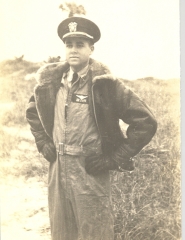Karl R. Marrs

Karl R. Marrs
KARL
R.
MARRS
SOLDIER DETAILS
BIOGRAPHY
Before WWII all Naval Air Cadets were required to have completed two years of college before being accepted for training as Naval Aviators. With that program in place the Navy had a limited number of combat pilots on December 7, 1941. A few days after the Japanese struck Hawaii, the Navy asked Rear Admiral Thomas Hamilton to develop an intensive program that would include physical, academic and spiritual training for high school graduates. That program would allow 18 year olds to enter Navy Pilot training program if they could pass the entrance exam and meet the physical requirements the Navy demanded. With that program in place, a local airport owner/pilot instructor started recruiting men just as Karl Marrs completed his solo flight check. By early September, 1942, he had a class of 17 ready to go to Kansas City. The five hour academic test went well for all 17 but the following day two were eliminated during the physical exam. At age 18, nine months after the bombing of Pearl Harbor, Karl R. Marrs had joined the Navy V-5 Flight Program with 15 of his home town high school classmates. Nine months after they started at the University of Iowa, he was one of three from the original hometown group to graduate at the Pensacola Naval Air Station and wear the Wings of Gold of a Naval Aviator. He soloed a PBY-5B at age 19 and flew that seaplane for several months before making the transition to the PB4Y-1 as a Co-Pilot/Navigator at NAS Chincoteague VA. After completing that training his crew flew a new PB4Y-1 (B24-J) to North Africa, via the southern ATC route and joined VPB-112, a squadron in Fleet Air Wing-15. His crew flew several Anti-Sub and convoy cover missions in the Gibraltar Funnel area before being transferred to England in early January of 1945, where they joined Fleet Air Wing-7. After completing 27 combat missions, in that area, they returned to the States for reorganization for duty in Alaska with the new PB4Y-2. Before that training was completed the hostilities with Japan had ended and he was released from active duty after a short stint in the South Pacific. The flying career for Karl was put on hold for fifteen years. After fifty years of livestock and grain farming in southern Kansas, Karl wrote a book, 'I WAS THERE WHEN THE WORLD STOOD STILL'. It was about his 'War Years' and just for his family. He wanted them to know that he was not a hero and did nothing but serve his country just as thousands of other young men and women had done during that period of history. Fifty-five years after WWII ended and just before the book went to press the Navy decided to award each flight crew member of Fleet Air Wing-7 the Distinguished Flying Cross and Air Medals for every five missions they had completed. That put a shade of grey on his attempt to downplay the hero bit for his family.
 Eisenhower Foundation
Eisenhower Foundation
